This article is packed full of information that will help you to self-drive Kruger National Park. It’ll help with planning and ensure you have all the knowledge you’ll need to embark on your Kruger safari and help you to find all the incredible animals of Kruger.
We drove from south to north on our self-drive through Kruger National Park, spending 8 weeks covering as much of its 3000 kilometres of roads as possible.
Deciding where to go and planning your Kruger itinerary will depend on your time frames, interests and the season. This Kruger guide will help you choose the best options for your own self-drive safari in the Park.
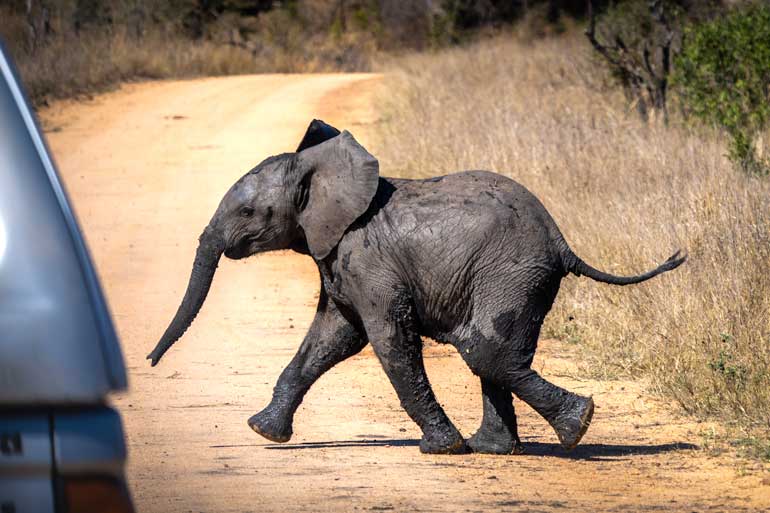
KRUGER SELF-DRIVE SAFARI: THE ULTIMATE GUIDE
This ultimate guide to self-driving through Kruger National Park is broken down into separate headings. To make navigation easier, you can also click on any of these links and jump straight to that section.
- WHAT TO EXPECT FROM YOUR KRUGER SELF-DRIVE
- KRUGER NATIONAL PARK MAP
- ABOUT KRUGER NATIONAL PARK
- WHERE TO GO IN KRUGER
- PLANNING YOUR KRUGER ITINERARY
- DRIVING TIPS FOR KRUGER
- GAME VIEWING TIPS FOR KRUGER
- ESSENTIALS FOR A KRUGER SAFARI
- WHERE TO STAY IN KRUGER (and personal campsite ratings)
- TIPS ON WHEN TO VISIT KRUGER
- HEALTH TIPS FOR KRUGER
- KRUGER ITINERARY COSTS
VIDEO HIGHLIGHTS OF OUR KRUGER SELF-DRIVE SAFARI
Here’s a quick 90 second peek at some of our Kruger self-drive highlights to get you in the mood:

If you’d love to watch the animal antics of those in Kruger then check out our Animals of Kruger National Park VIDEO — It’s packed full of funny, cute and awesome wildlife moments in Kruger.
1. WHAT TO EXPECT FROM YOUR KRUGER SELF-DRIVE
One thing you can be assured of on your Kruger self-drive is an incredible insight into the workings of nature and its unpredictability. What you expect to see may not eventuate, and what you aren’t expecting, may suddenly appear out of the blue.
Expect to be surprised, frustrated and enthralled, but above all …
… expect to fall in love with this piece of African paradise
Throughout our time driving through Kruger, we experienced some rare sightings and many moments that were so special that we just wanted time to stand still.
We also had times when Lady Luck decided to take the day off.
You cannot drive Kruger with an ‘expectation’.
If you do, you may be disappointed.
You must embark on your Kruger self-drive with a sense of curiosity, and interest, and it all must be sprinkled with a good dose of patience.
A prime example of Kruger’s unpredictability is the amazing incident that occurred on a dusty Kruger track one early afternoon.
After a fruitless morning drive, we were heading back to camp in our 4×4 Bush Camper, when I spotted a weird-looking shape ambling across the road ahead. It just so happened that weird shape turned out to be one of Kruger’s most rare and endangered animals.
Not only is it extremely rare to spot this vulnerable little creature in Kruger, but it is also nocturnal, so to spot this little gem in the middle of the day was even more of a surprise.
With ‘unpredictability’ working at its best, we were looking at no less than a beautifully armoured pangolin.
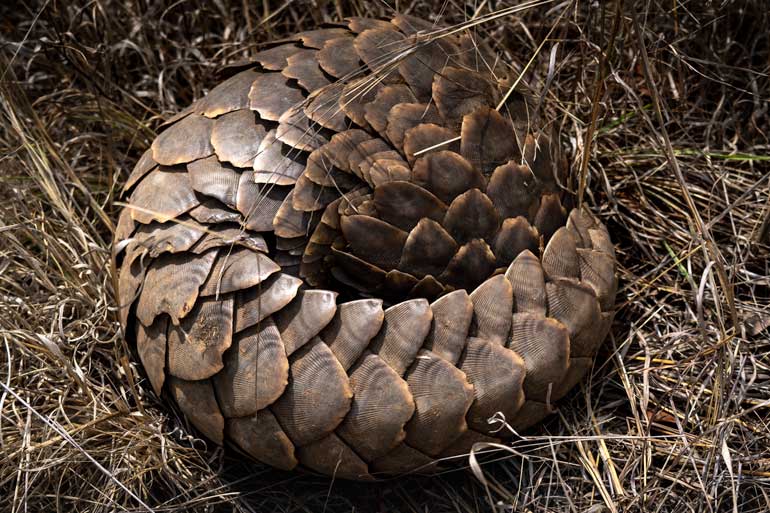
So, you really never know what is around that next corner, under the next bush or about to cross the path right in front of you.
You may drive for hours with only the African bush staring back at you. Though I’m pleased to say, you would be woefully unlucky not to see anything in Kruger. You should, at the very least, find Impala gracing the fringes of most Kruger roads.
Nature offers itself up but with no guarantees.
So where is the best place to be in Kruger?
The best place to be in Kruger is simply being at the right place at the right time … and that’s not something you can plan for.
Thinking of hiring a bush camper in South Africa?
We recommend using Motorhome Republic to find you the best deal – they search all the local reputable African rental companies, for example, Avis Safari, Britz and Bobo Campers.
They do all the hard work for you and are available 24/7 to help you.
We used them when renting for 12 months in Europe and not only was the customer service excellent but they were able to find us better offers than when we approached the companies ourselves.
Since Covid, there has been a worldwide shortage of campers and limited availability, so do book early to make sure you can rent the vehicle that suits you best.
2. KRUGER SELF-DRIVE MAP
HOW TO USE THIS KRUGER SELF-DRIVE MAP
To use this Kruger map, expand it using the square symbol on the top right-hand side and then you will find the key on the left-hand side.
- The 12 main rest camps (campsites) are marked in blue, other than the
- Rest Camps we stayed in, are marked in orange.
- The most popular routes and destinations are marked up and are colour coded for south, central and north Kruger.
- These places are also discussed further in this article, under ‘Where to go on your Kruger Self Drive’.
3. ABOUT KRUGER NATIONAL PARK
Back in 1898, the presiding President of what was the Transvaal Republic at the time, Paul Kruger, recognised the need to preserve the declining wildlife from overhunting and poaching and proclaimed the Sabie Game Reserve.
In 1926, the area was renamed, Kruger National Park. and was opened to the general public in 1927.
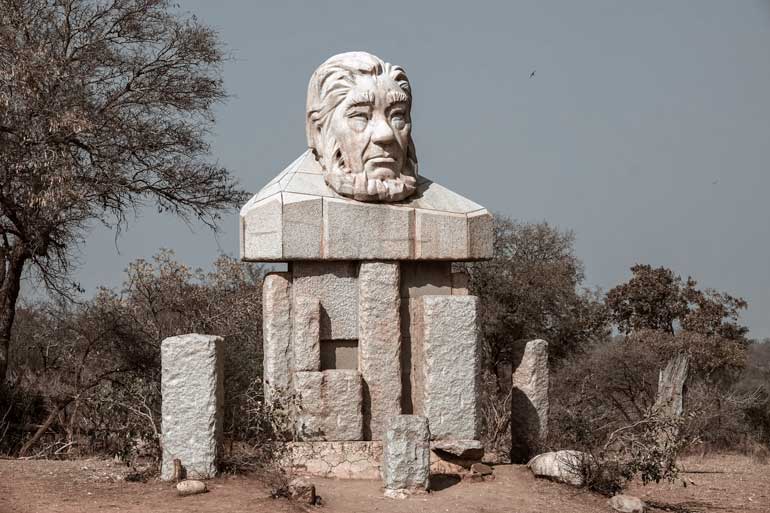
In 1993, fences between the adjacent private nature reserves, including Klaserie Nature Reserve, where we had the most incredible bush life experience, were removed. This meant that the wildlife could migrate freely between a larger area.
Kruger National Park is now one of the largest game reserves in Africa. You’ll find this wildlife paradise in the northeast of South Africa extending 360km from north to south and 65km from east to west.
GETTING TO KRUGER NATIONAL PARK
There are ten entry gates into Kruger National Park and the best one for you depends on where you are arriving from and where you intend to begin your Kruger self-drive itinerary.
The southern gate is Malelane Gate which is about a 4.5 to 5 hours drive (about 400km) from Johannesburg on the N4 via Nelspruit.
The other gates throughout Kruger are;
- Crocodile Bridge,
- Giriyondo,
- Numbi,
- Orpen,
- Pafuri,
- Paul Kruger,
- Phabeni,
- Phalaborwa and
- Punda Maria.
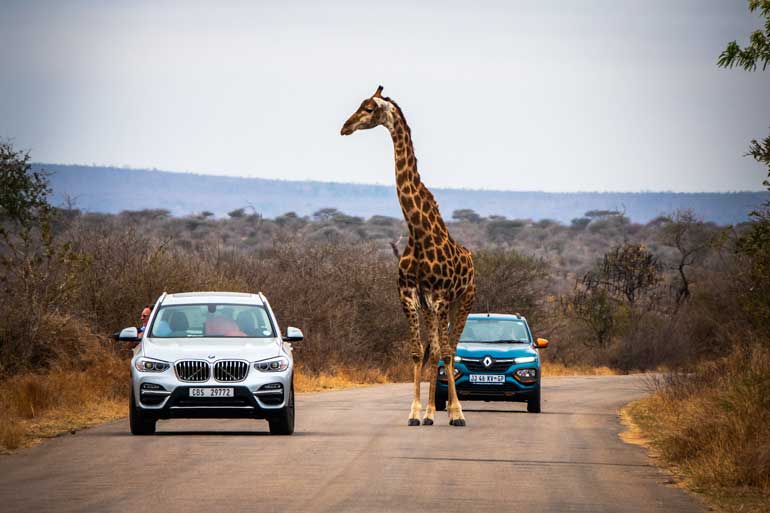
KRUGER NATIONAL PARK ENTRANCE FEES
On arrival at a Kruger gate, you will be asked to show confirmation of your booking and asked to register using this form.
The Gate fees can be paid online when you book or are free if you have a wildcard.
The cost of entry to Kruger National Park varies depending on your nationality and residency:
- South African citizens: R115 per adult/ per day
- Non-South Africans: R460 per adult/ per day (approx USD 30, AUD 40, GBP 22)
To stay overnight in Kruger National Park, you must have booked your accommodation ahead of time. Oftentimes you need to book well in advance in order to get the campsite that you want.
Note that if you are an international tourist and are going to be on your Kruger Park self-drive for 13 days or more it works out cheaper to buy the Wildcard.
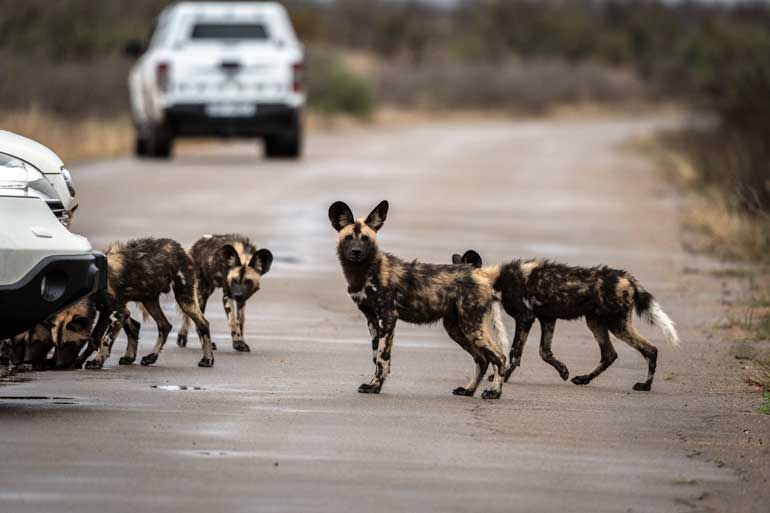
KRUGER GATE TIMES
Kruger’s entrance/closing gate times vary slightly depending on the time of year.
Generally, from April to September, the gates are open from 6 am to 6 pm and from October to March from 5.30 am to 6.30 pm.
The entrance gates and camp gate times can also vary slightly — with camp gates opening an hour earlier than the entrance gates in summer.
For up-to-date Gate open times click here.
KRUGER REST CAMP GATE TIMES
If you are staying in one of Kruger’s rest camps make sure you leave enough time to get back to camp before the gates close otherwise you may incur a fee.
We asked whether there was any leeway on returning late and … off the record, you will usually be ok if you are just a few minutes late. You may also be able to avoid a fine if you have a good reason for not being at the gate on time. An example could be that an elephant was blocking the road … I expect many people use this excuse, so having photo or video evidence may help your case.
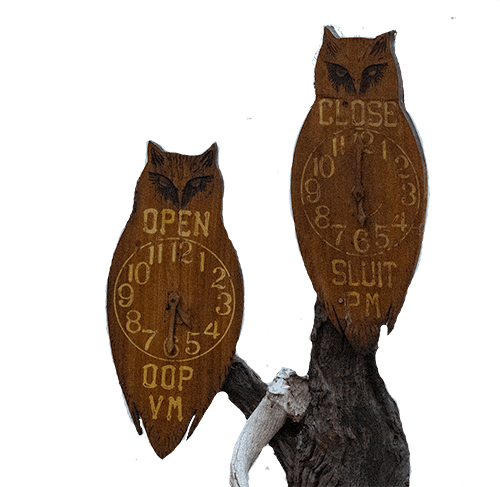
4. WHERE TO GO IN KRUGER NATIONAL PARK
Kruger National Park is a large area that can roughly be divided into three sections, north, central and south Kruger.
Here are overviews of each area, detailing;
- Rest camps in those areas,
- The type of game viewing you can expect, and
- Popular self-drive routes.
The rest camps themselves have been rated with more details further on in this post.
SOUTH KRUGER
MAIN REST CAMPS IN SOUTHERN KRUGER:
- Crocodile Bridge,
- Berg-en-dal,
- Skukuza,
- Lower Sabie,
- Pretororiuskop,
GAME VIEWING IN SOUTH KRUGER
Southern Kruger is the most popular area for visitors to self-drive, due to the more prolific wildlife in the area. Big cats are seen here more regularly, as well as white rhinos.
Due to the popularity of South Kruger, be prepared to share sightings with many others.
Known for: Rhino, lion, cheetah, leopard, wild dogs,
What we saw: Lions, leopards, wild dogs, rhinos, giraffes, zebra, steenbok, impala, Nyala, baboons, vervet monkeys, elephants, buffalo, kudu, waterbuck, hippos in and out of the river, and pangolin.
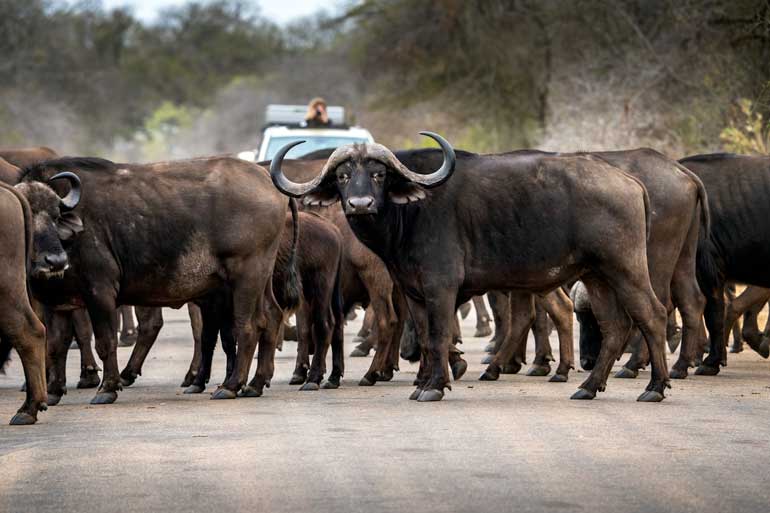
POPULAR KRUGER SELF-DRIVE ROUTES IN SOUTHERN KRUGER
See our Kruger Self-drive map for locations on these Kruger routes.
- Biyamiti Weir Viewpoint: Hippos, crocodiles, birdlife and giraffe
- H4-2 Crocodile Bridge to Lower Sabie: This road is known for spotting rhinos and cheetahs
- The H4-1 north of Lower Sabie Rest Camp: Drive along the picturesque Sabie River and take a detour along the N’watimhiri Causeway
- Sunset Dam (near Lower Sabie Rest Camp): The perfect place to chill and watch the various animals come to drink whilst the resident hippos and crocodiles watch on. Here you’ll see plenty of water birds and you may even spot the herons hitching a ride on the hippo’s backs.
- Lubyelubye River Crossing: There are a few pull-ins to the left as you drive south towards Lower Sabie, just before the crossing which gives awesome views of the river. This spot is also a good place to spot leopards and lions.
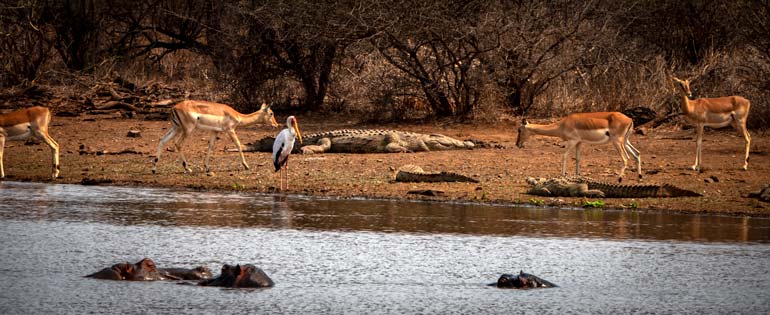
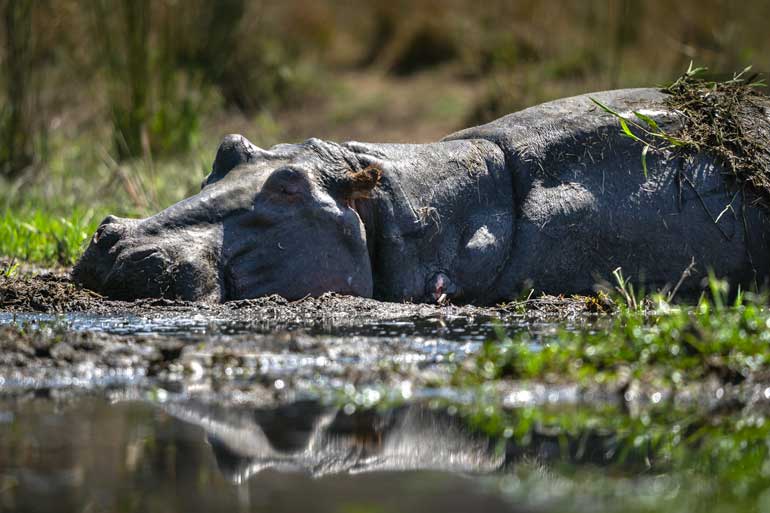
CENTRAL KRUGER
MAIN REST CAMPS IN CENTRAL KRUGER
GAME VIEWING IN CENTRAL KRUGER
Central Kruger has a more open savannah where you can find zebra, and wildebeest and spot the odd ostrich. Near the rivers, you are likely to find troops of baboons and vervet monkeys, hippos and crocodiles.
Known For: lion, cheetah, leopard,
What we saw: Lions, giraffes, zebra, steenbok, impala, baboons, vervet monkeys, elephants, kudu, waterbuck, blue wildebeest, honey badger, hyena and lots of Swainson spurfowl by the roads.

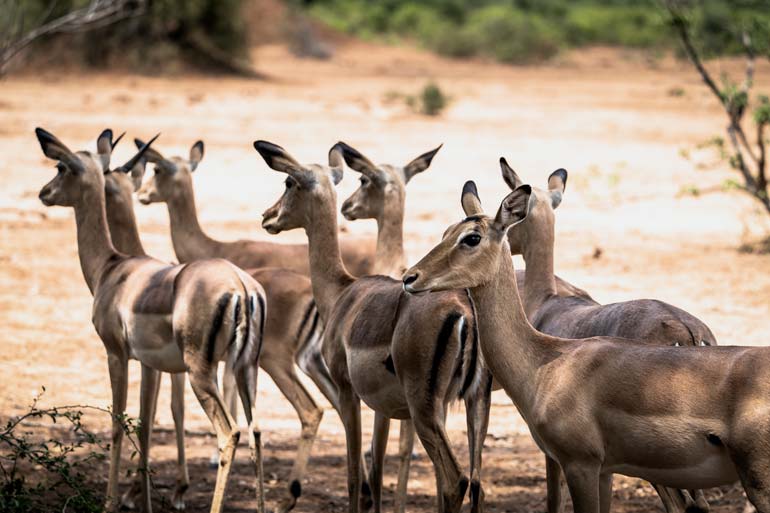
POPULAR SELF-DRIVE ITINERARY ROUTES IN CENTRAL KRUGER
- The S100: This Kruger self-drive route has a mixture of riverine landscape and open savannah and is apparently known for great sightings. However, we saw plenty of grazers here but, even though we drove it about 5 times, we never saw any predators.
- The Sweni Bird and Game Hide: A lovely dam with hippos, crocs and plenty of waterbirds.
- H1 -3 Tshokwane Picnic site to Satara: There is lots of open savannah on the route, so it’s relatively easier to spot the game. The picnic area at Tshokwane overlooks the river. Here we watched elephants digging holes in the sand to get to the water underneath. This is a nice spot to grab a hot pie – you can try kudu and buffalo versions if that takes your fancy.
- Most Southern naturally occurring Baobab Tree: You’ll find this near the Kumana Dam.
NORTH KRUGER
MAIN REST CAMPS IN NORTHERN KRUGER
- Mopani
- Shingwedzi
- Punda Maria
GAME VIEWING IN NORTH KRUGER
The game viewing in the north of Kruger is not as prolific as in the south and therefore there are fewer visitors in this area. This means that any viewings you have are likely to be far less crowded. The area attracts a wide variety of birds and is known as one of the premier birding areas in the world.
Known for: Elephants (including big tuskers), a plethora of birds
What we saw: Elephants, leopards, baboons, vervet monkeys, impala, waterbuck, kudu, hippos, Grysbok, nyala, zebra and giraffe.
POPULAR SELF-DRIVE ROUTES IN NORTHERN KRUGER
- Bird watcher’s paradise in the whole area
- Pass through the Fever-Tree Forest on the way to Crooks Corner
- Huge ancient Baobab Trees are in this area – with the most ancient being north of the Luvuvhu River
- Pafuri Picnic site
- Babalala Picnic Site
- Mphongolo Loop (our favourite route of all)
- Shingwedzi Loop (S52)
- Red Rocks Lookout
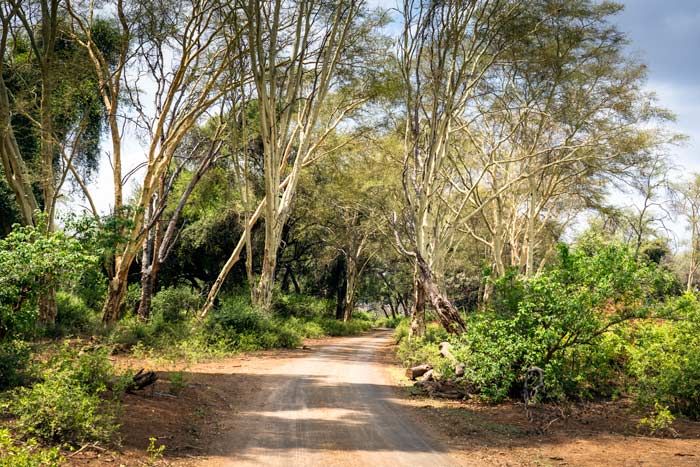
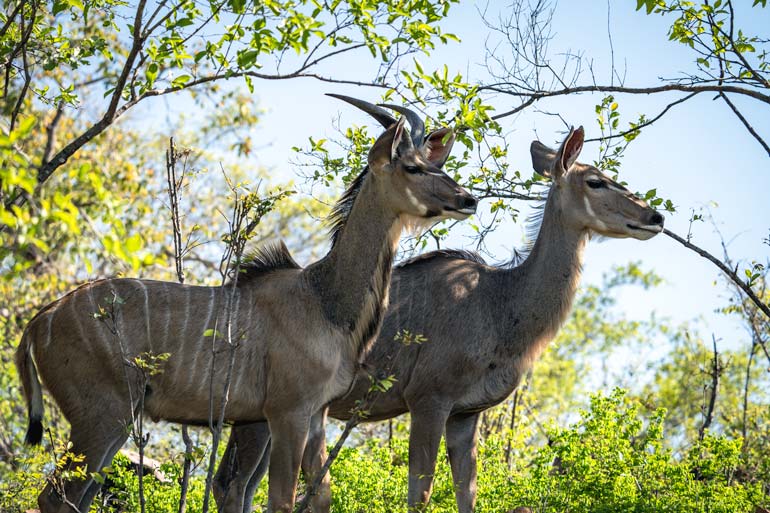
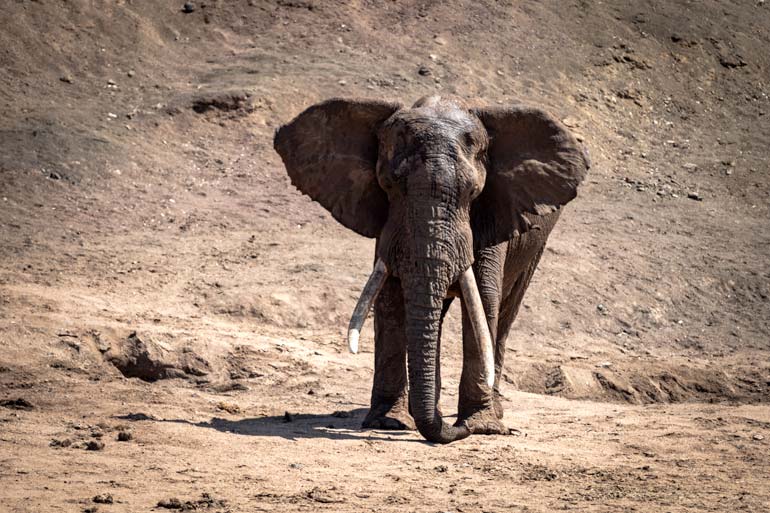
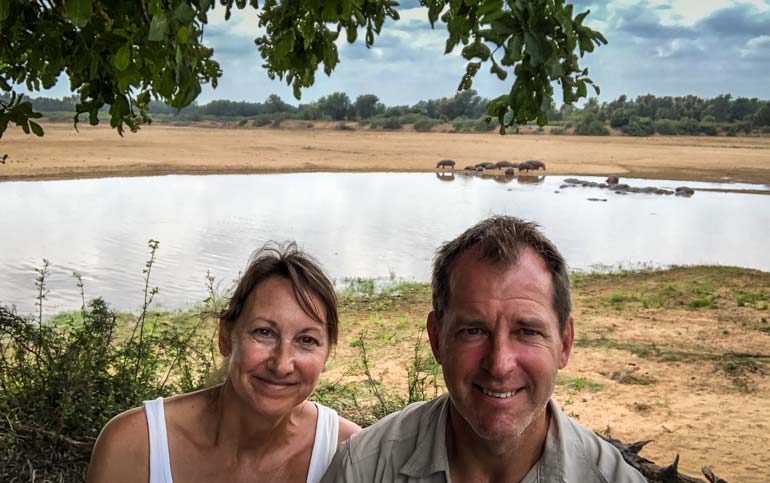
5. PLANNING YOUR KRUGER ITINERARY
Depending on how much time you have in the park and what type of schedule you like to plan, (busy or more relaxed), will determine what your daily Kruger itinerary may look like.
Some people like to spend the whole day driving — stopping at a picnic site for lunch and returning just before the rest camp gate closes, (normally at 6.00 pm in Sept/Oct).
However, if you find the idea of driving all day too tiresome, then we suggest setting out early in the morning, (gates open in the rest camps at 6 am in September and 5.30 am in October), stopping for morning tea at a nice pullover, and returning for a late lunch.
You then have an afternoon of rejuvenation before repeating the process the next day.
It is good to use a detailed map to plan your daily itinerary so you can include viewpoints, waterholes and picnic sites. You can buy a map at every rest camp or you can download the invaluable Kruger Explorer App.
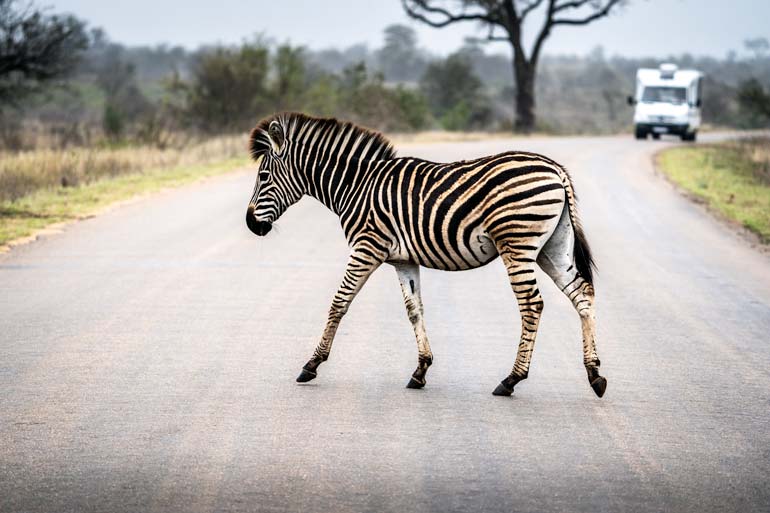
6. DRIVING TIPS FOR YOUR SELF-DRIVE SAFARI
1. FOLLOW THE SPEED LIMITS
The speed limits in Kruger National Park range between 50 km/hour on tarred roads and 30/40 km /hour on gravel and dirt roads. However, to maximise your game viewing while driving in Kruger National Park, the slower you drive, the better. We drove an average of 20 – 25km/hr most of the time.
2. LEAVE BRAKING ROOM
Leave enough braking room between you and the driver in front – they may just slam on their brakes if they suddenly spot something or an animal runs out onto the road.
3. KRUGER’S ‘H’ AND ‘S’ ROADS
The roads in Kruger National Park are numbered and preceded by an S or an H.
- The H-numbered roads are tarred roads and
- S-numbered roads are gravel roads.
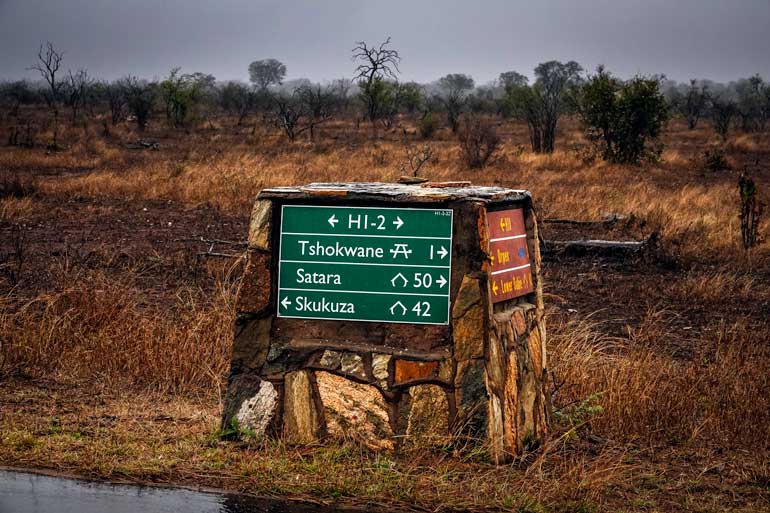
4. DON’T ASSUME THERE ISN’T ANYTHING TO BE SEEN IF THE CAR IN FRONT DOESN’T STOP
Don’t assume that just because there is a car in front of you that they would have spotted something if it was there. Still, look around because they could easily have missed something or they may not be interested in stopping to look at whatever may be there.
5. BEWARE OF THE SIGHTING HOARDERS
Sometimes being at a sighting can feel like being in the January sales, everyone wants a piece of the action. Courtesy can often be lost in the foray of cars vying for the best vantage point.
6. WATCH OUT FOR THOSE CHASING A SIGHTING
Don’t be surprised if you come across some drivers speeding along like maniacs — they are probably using the Kruger sightings app and rushing to get to a reported sighting, along with all the others using the same app.
7. IT’S OK TO DRIVE ON THE WRONG SIDE OF THE ROAD
Don’t be afraid to drive on the wrong side of the road if you are travelling along a river — it’s the ‘done thing’ in Kruger, so you can get a better view. Drive slowly and make sure to keep your eye on the road for oncoming traffic and move over to the correct side until they have passed.
8. WHAT A PROCESSION OF CARS MAY MEAN
You might come across a procession of cars moving along the road with drivers straining their necks trying to follow a lion or leopard through the bush. The thrill of the chase is quite exciting … and the animals seem unperturbed and are obviously habituated to the mechanical hums hot on their tails.
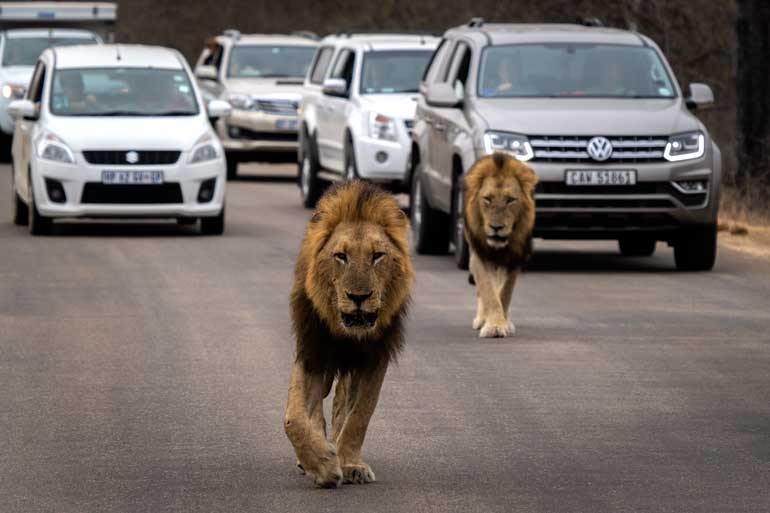
9. TURN OFF YOUR ENGINE
It is a good habit to turn off your engine if you are going to be stopped for a little while because it makes for a much more relaxed and pleasant experience for everyone when the car engines are off.
10. PAY ATTENTION TO ELEPHANTS
The wildlife in Kruger is habituated to vehicles on the roads, along with engine noises. Even so, many will startle and run away — especially if you are moving too fast.
However, you do need to be particularly careful driving near elephants. Female elephants can be very aggressive if they feel that their calves are in danger and can feel uneasy with you being in close proximity.
Male elephants, the bulls, can also be aggressive if they are in Musth. You may notice them dripping urine and/or notice a dark fluid between the ears and eyes. You will also likely smell a strong nose-crinkling odour.
Keep your distance and if you sense that they are bothered by you, either back up slowly or drive on slowly. If they are blocking the road then wait for them to move on and never block their passage.
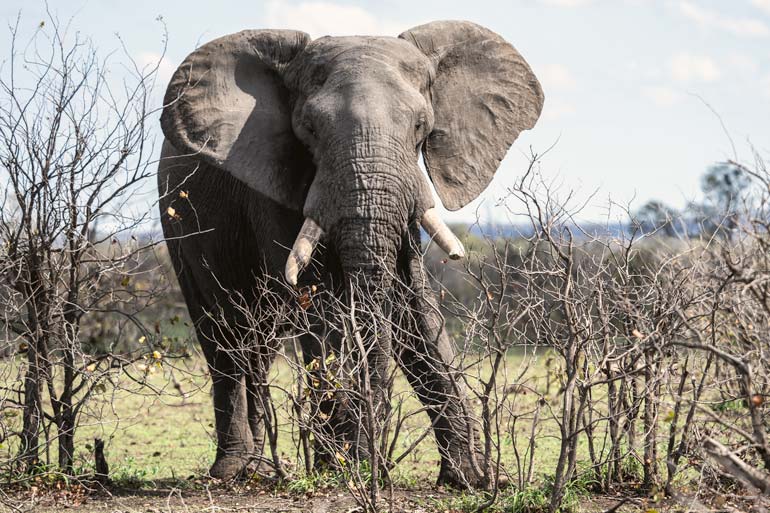
11. ASK OTHERS WHAT THEY ARE LOOKING AT
If you see someone stopped at the side of the road, ask what they are looking a — it’ll save time searching through your own binoculars when they might just be admiring the view.
12. EXPECT OTHER DRIVERS TO TELL YOU WHAT THEY SEE IN THE OTHER DIRECTION
You’ll likely find that some drivers coming in the opposite direction will slow down and tell you what is up ahead. If it is a leopard in a tree or sleeping lions then they may still be there when you arrive.
However, sometimes this can lead to frustration and disappointment because you get your hopes up and by the time you arrive, the animals have disappeared into the bush.
This happened to us several times. Once we were promised a pride of 22 lions just a kilometre down the road and another time a leopard with two cubs. Excitedly we drove on, hopes now raised at what would certainly be momentous experiences.
On both occasions, we saw zip.
13. STAY IN YOUR VEHICLE
Unless you are in a rest camp or in a designated area you need to stay in your vehicle.
14. DRIVE WITH WINDOWS DOWN
You will note that on the Kruger National Park Entry booklet, it says to keep windows closed at all times. However, this would restrict your safari experience and we recommend keeping your windows open. Obviously, close them if you feel uncomfortable at any time or sense danger.
With your windows open, it is much easier to spot movement and colour variations in the bush (an animal silhouette). You are also more likely to hear the wildlife and hear cues that can alert you to nearby animals.
For example, impalas ‘bark’ when they see a predator, as do baboons. We spotted two leopards on our Kruger drives by stopping when we heard impalas barking.
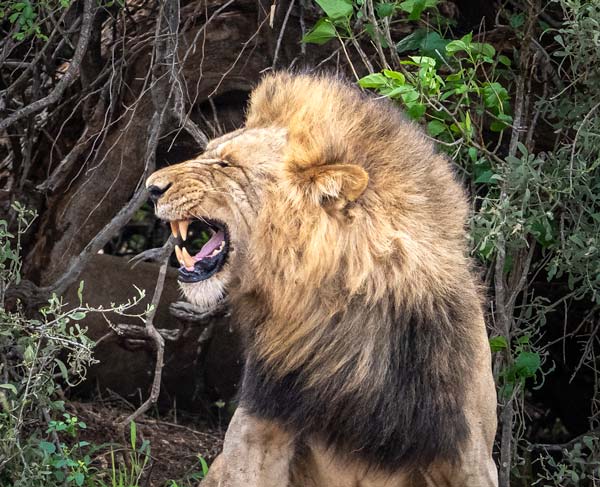
15. BE READY TO USE REVERSE GEAR … A LOT
As you drive along in Kruger, you will suddenly spot a movement or see a shape that you think might be an animal. So you will need to reverse and check it out. I lost count of how many times I told Lars to stop and go back. Many times we reversed, for me only to confirm it was a log or a rock.
Get used to seeing many tree stumps that look like they have ears ;).
However, other times, that slight movement or shape that caught our eye was indeed an eagle-eyed sighting. Our best ‘reverse’ was when I saw a dappled shadow in a tree and it turned out to be a leopard taking a nap.
16. BE AWARE OF GATE CLOSING TIMES
Leave enough time to get back to the camp, or out of the park, by the gate closing times.
17. FUEL IS AVAILABLE AT 12 REST CAMPS
There are gas stations at each of the 12 main Rest Camps in Kruger National Park
18. EMERGENCY BREAKDOWNS
There is a toll-free number to use for any vehicle breakdowns or emergency repairs: 0800 030 666
7. GAME VIEWING ON YOUR KRUGER SELF-DRIVE
At each camp, there are sightings boards that give you an idea as to what animals have been spotted in the area. These can help you plan your day’s driving route.
Ideally, we’d recommend staying at least three days (if not more) in each rest camp so you can explore all the great self-drive routes and tracks in the area.
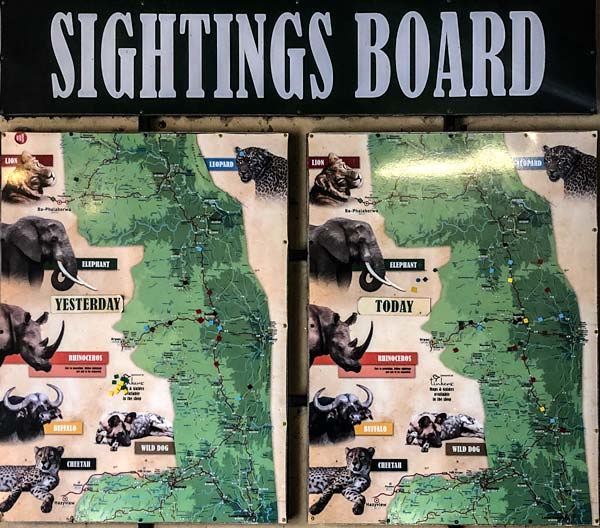
Kruger has a variety of landscapes that offers the opportunity for varying game views.
In the dry season, the availability of water determines the movement and congregations of animals, so pay close attention to waterholes, dams and rivers.
Most articles we have read, while researching for our own Kruger self-drive, stated that the best game viewing was in the early morning and before dusk. However, during our 8 weeks in Kruger, the early mornings were only slightly more productive and the late afternoon sightings were quite sparse.
For those who love photography though, the best lighting is definitely in the early morning and just before sunset, when the orange light brings the wildlife and safari settings alive.
Remember that the unpredictability of wildlife is your wild card and you just never know what is around that next bend in the road.
8. ESSENTIALS FOR YOUR KRUGER SELF-DRIVE
These are some of the essentials that we thought were really useful on this self-drive in Kruger:
1. Binoculars
Binoculars are an absolutely essential item for your Kruger safari. There will be times when the wildlife is too far from the road for you to see clearly and, even when you are relatively close to an animal, you can get great close-ups and see the detail you’d miss otherwise.
Our binoculars were invaluable and we used them constantly. Find the price on Amazon here
2. Air Conditioning/ Heating
Obviously, the temperature in the park will vary depending on the time of year that you do your Kruger self-drive. Either way, recommend doing your self-drive safari in a vehicle that has both air conditioning and heating.
This is because, even in the winter months, days can be quite warm. We were in Kruger Park in September and October and on some days, the temperatures reached 39 degrees Celsius.
Therefore, having air conditioning in your vehicle makes your Kruger safari much more comfortable. Especially given that a large part of your time is spent driving in your vehicle. Some days it was too hot to sit in camp so we were out driving in our air-conditioned camper just to cool down.
In contrast, the mornings and also some afternoons can be quite chilly. Particularly if you are driving with the window down and taking photos. Therefore, it’s a bonus to be able to crank up the heating.
3. Camera
Whether you are a seasoned photographer or just want to capture your experiences, you will likely be shooting plenty of wildlife.
Remember to have spare batteries and memory cards to hand for your cameras and to have charging capability for your iPhone or Android.
READ MORE: Tips for Road Trip Photography
4. Kruger App
Having maps that show the various viewpoints, waterholes, dams and rivers really helps you to plan your Kruger itinerary. An app that was invaluable to us was the Kruger Explorer.
We used the app for its detailed maps, suggested routes and itineraries and fabulous details about all of the wildlife you may encounter as you drive through Kruger.
The Kruger Explorer app also works offline, which is useful because much of Kruger does not have a wifi signal outside of the rest camps.

5. Kruger Map and Guide
The Kruger Park Map and Guide – a Photographer’s Guide on Travelling the Kruger Park, is available in all of the rest camp shops and is worthwhile buying if you like having a physical map, route guides and an animal and bird checklist.
It is packed with useful information and well worth the cost.
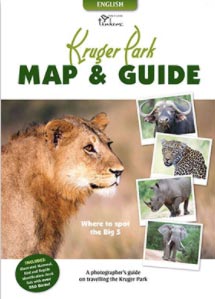
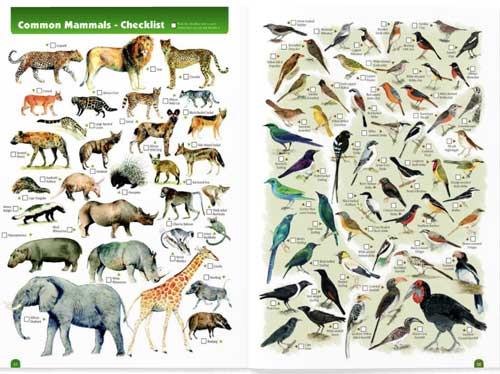
6. Patience
Enjoy the scenery and the little things as well as the search for those elusive sightings.
7. Flask, Water, Snacks
In Kruger National Park, you are not allowed to get out of the car — except in designated viewpoints and picnic spots.
Therefore, to make your drive more enjoyable, pack a flask of tea or bring along a few litres of water and a bag of snacks to keep you hydrated and well-fed on your game-driving missions.
9. WHERE TO STAY ON YOUR KRUGER SELF-DRIVE ITINERARY
Kruger National Park is run by SANParks and has twelve main rest camps, all of which have a shop, restaurant and petrol station. Some also have swimming pools, and some have decks overlooking their adjacent rivers.
Most of the rest camps offer a variety of accommodations, ranging from tent and caravan parking, basic huts (using communal bathrooms and kitchens), bungalows, safari tents and guest houses.
There are also six bushveld camps (no self-camping) and four satellite camps which are more expensive than the main rest camps.
Obviously, the cheapest accommodation in Kruger is the rest camp’s campsites, and as we have our 4×4 bush camper with a tent on top, we stayed in six of Kruger’s rest camps on our self-drive itinerary.
Here’s our ‘Buckie’ which is our accommodation on wheels, so we were able to use camper parking in Kruger’s rest camps. This is the video we made after adding the modifications to make our Africa travels easier.
Below, we’ve rated the six rest camps we stayed in below and the game-viewing opportunities we experienced in each area.
We’ve also included the price of one night for a powered campsite in October so you can compare prices. For current tariffs and all other accommodation prices, go to SANParks Kruger National Park site here.
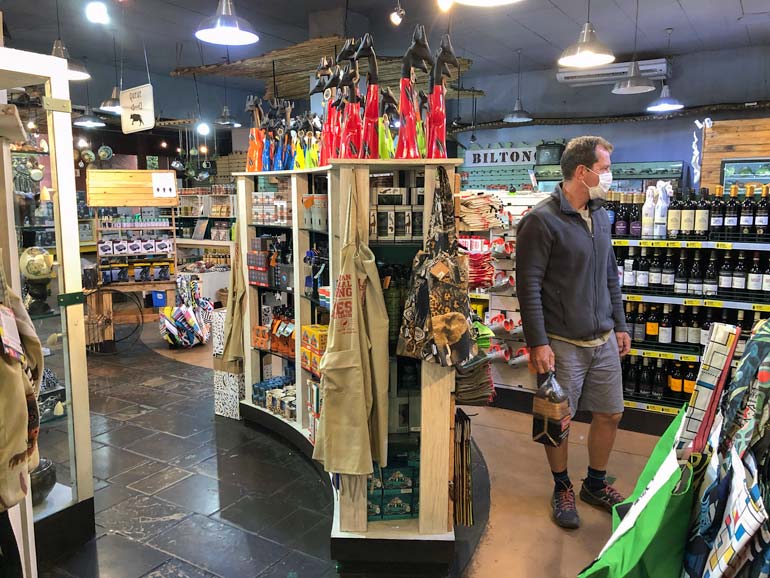
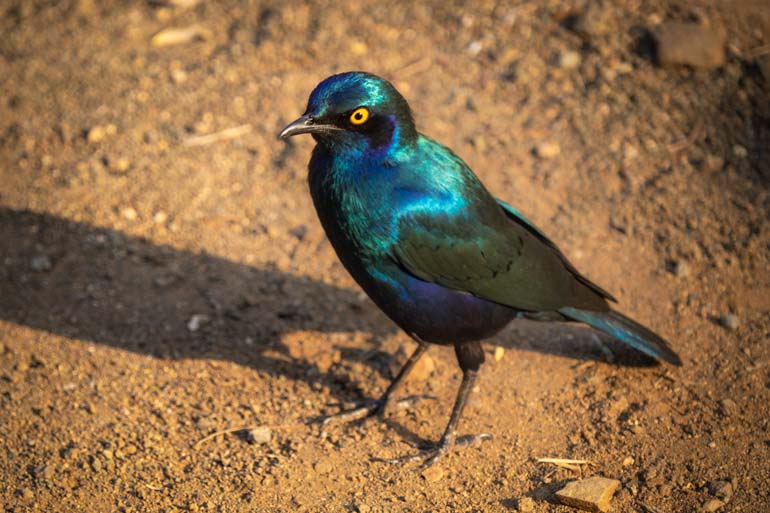
LOWER SABIE REST CAMP (SOUTHERN KRUGER)

♦ Cost per night for two on a powered site: R 380 – R 445 (depending on dates)
- The individual sites in Lower Sabie were well-defined, and each was a good size.
- Many sites had bushes and trees between them.
- The reception, shop and Mugg and Bean Café were all within easy reach and well-maintained.
- The Mugg and Bean Café had plenty of seating and the deck overlooked the Sabie River so you could have a coffee and watch the baby hippos playing in the river.
- The game drives around the camp were very productive and the landscape was very scenic with plenty of river views.
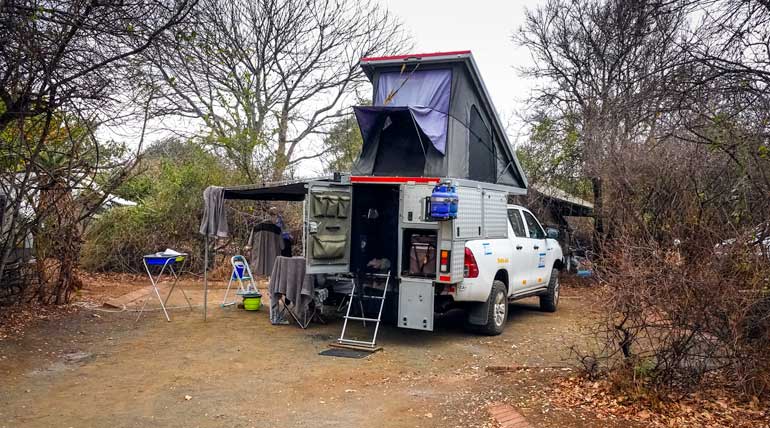
SKUKUZA REST CAMP (SOUTHERN KRUGER)

♦ Cost per night for two on a powered site: R 330 – 455 (depending on dates)
- Skukuza is the largest of Kruger’s rest camps and has several restaurant and café options.
- There is also the ‘Station‘ — a complex that particularly caters for families. It has a deli, restaurant, bar, 360° cinema, coffee and ice-cream café and a kid’s zone.
- There is a doctor on site.
- We had a few visitors in camp – a grumpy warthog and lots of vervet monkeys. Remember to pack all goods away, especially any food when not attended, or the monkeys will take them.
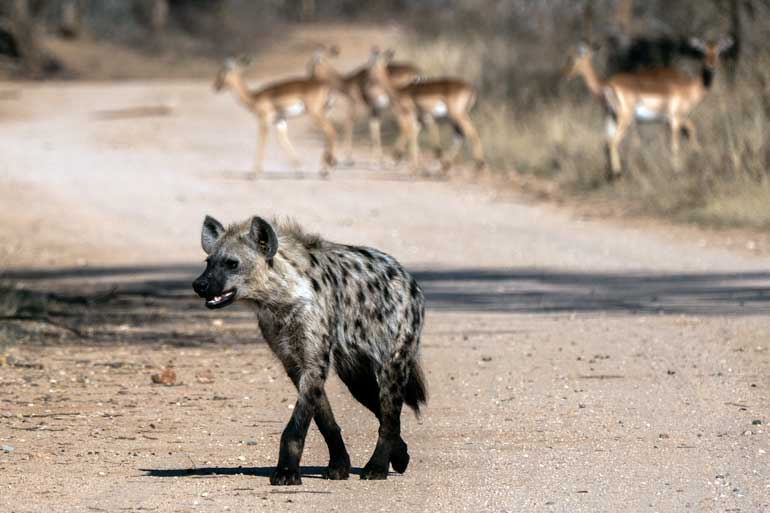
SATARA REST CAMP (CENTRAL KRUGER)

Cost per night for two: R330 – 455 (depending on dates)
- Satara is known as the big cat area. We stayed there for five nights and unfortunately, the weather wasn’t the best – it rained most of the time which doesn’t lend itself to excellent game viewing.
- The campsites are a bit higgledy-piggledy and not easily definable.
- The shower and toilet ablutions were basic.
- Satara is the second largest campsite in KNP
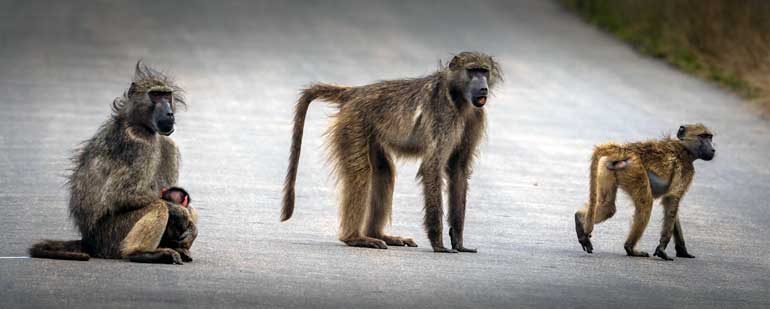
LETABA REST CAMP (CENTRAL KRUGER)

Cost per night for two on a powered site: R320 – 433 (depending on dates)
- The elephant museum is definitely worth a visit to give you a deeper understanding of these magnificent beasts.
- Watch out for the baboons here – they were stealthily stealing anything they could lay their hands on.
- The sites were well set out here and quite a few were by the fence where the hyena prowled at night.
- A nice shady campsite with resident bushbuck.
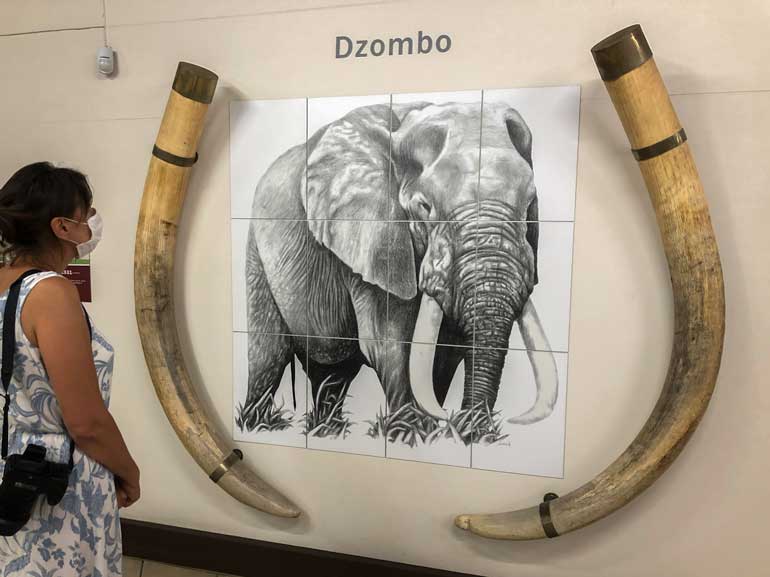
SHINGWEDZI REST CAMP (NORTHEN KRUGER)

♦ Cost per night for two on a powered site: R320 – 497 (depending on dates)
- Toilet facilities were easy to get to and well maintained.
- There was hardly any shade in the campsite and was open plan.
- Shingwedzi was our favourite area for game viewing and scenery.
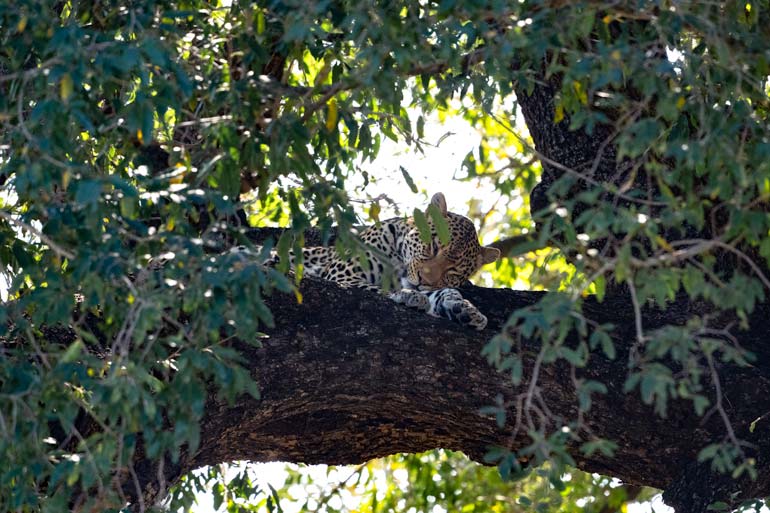
PUNDA MARIA REST CAMP (NORTHERN KRUGER)

♦ Cost per night for two on a powered site: R320 – 433 (depending on dates)
- The scenery around Punda Maria is beautiful – especially around the S99 loop close to the camp. Though sightings of big cats are less, the lush beauty and more remote setting is appealing.
- The big drawcard for the camp is that there is a waterhole right beside the camp where the elephants frequent regularly. A perfect spot to sit for a sundowner.
- The campsites were not clearly defined and in places difficult to discern which were actual sites. Many campers needed an extra-long power cord to reach the electricity points.
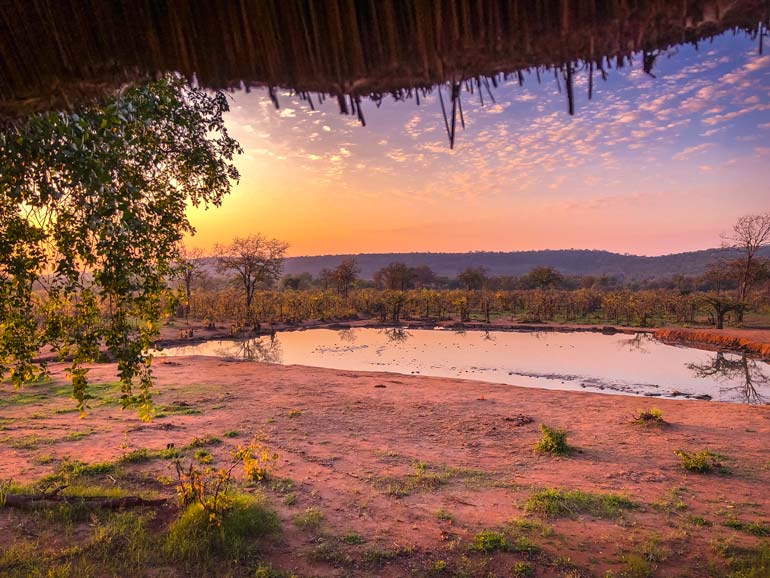
BOOKING YOUR KRUGER CAMPSITE
You can directly book your stay with SANParks in Kruger rest camps here:
Book online directly with SANParks
10. WHAT’S THE BEST TIME TO SELF-DRIVE KRUGER?
The best time to plan your self-drive itinerary through Kruger National Park is in September or October. The dry winter months of June, July and August have caused the bush to die back, making it much easier to see the wildlife.
In addition, by the end of the winter, water is sparse, so the animals tend to congregate around water sources such as waterholes, dams and rivers.
The weather in September and October can be a little temperamental, but the temperature is generally warm, around the mid-20s.
There can be cold spells, however, with rain or extra-warm days heating up to the early 30s or even higher. Temperatures reached the high 30s when we were there in October.
These months tend to be the busiest months in Kruger, so you will also need to book your campsite or accommodation well in advance. We booked in early March for September and October campsites and some camps were already completely booked out.
The summer months are less busy, visitor-wise, and the bush will be green and blooming. There will be more birdlife, but the game will be more difficult to spot. Insects, bugs, snakes and scorpions will also be more abundant so you will need to take extra care.
This free app, by the African Snakebite Institute, profiles all of the snakes, scorpions or spiders you may come across and provides details of first-aid information, nearest hospitals and emergency numbers.
Click here for details of the app.
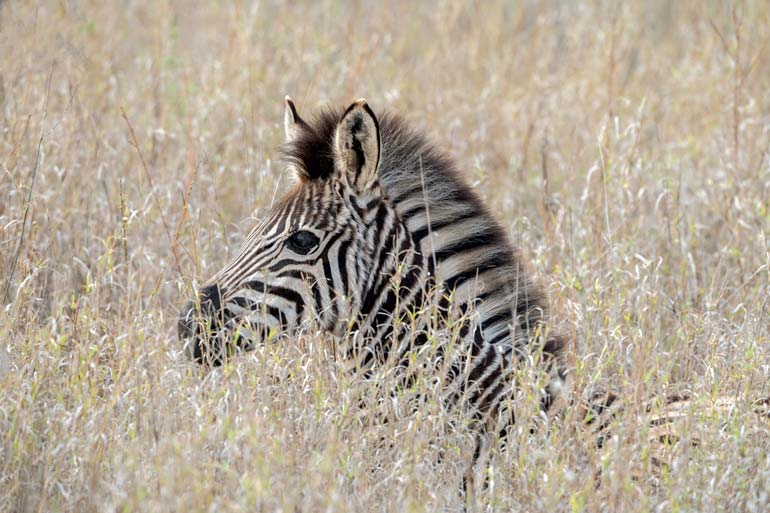
11. HEALTH TIPS FOR A KRUGER SELF-DRIVE
Malaria Risk in Kruger
Kruger is a low-risk malaria area so you will want to consider using prophylaxis — especially if you are travelling in summer. I took Doxycycline the whole time we were in the area because mosquitos gravitate toward me and love to feast, so I wasn’t prepared to take any chances.
Insect Repellent
Use insect repellent and cover up with light clothing before dusk when mosquitoes are most active.
We used a combination of Tabard mosquito repellent and Skin-so-Soft Bug formula. Both worked well.
Doctor in Kruger
If you are sick or need medical attention there is a doctor based at Skukuza Rest Camp. It is easy to make an appointment and the cost is around R650. We were able to get an appointment on the same day.
The 24-hour phone line is (013) 735 5638
12. KRUGER SELF-DRIVE ITINERARY COSTS
SANS PARKS CONSERVATION FEES AND WILDCARD
In all of the SANParks within South Africa, there is a daily conservation fee per person:
South African citizens: R115 per adult/ per day
Non-South Africans: R460 per adult/ per day (approx USD 30, AUD 40, GBP22)
This amount soon adds up if you are in Kruger National Park for any length of time.
However, if you buy a Wild Card this covers all conservation fees. Therefore, depending on your planned itinerary, you may want to purchase this.
South African Residents can buy a wild card for different clusters of National Parks but if you are not South African, you can only buy a card that includes all SansParks.
Wild Card prices:
One adult: R3,575 (approx USD 230, AUD 310, GBP 175)
Couple: R5,585 (approx USD 360, AUD 490, GBP 275)
You can use the receipt or your passport/id number as proof of purchase – you don’t have to have the actual card.
We didn’t have a physical Wild Card for the whole time we were in South Africa and that was fine.
If you are a foreign couple travelling in South Africa – and intend to spend 13 days or longer in any of South Africa’s National Parks then it is worth buying a Wild Card.
KRUGER SELF-DRIVE COSTS TO CONSIDER:
- Kruger National Park entrance fees
- SANS Parks Conservation Fees
- Kruger Campsite fees /or accommodation you choose
- Petrol costs
- Food costs
- Additional tour guide costs (if you want to experience a night drive for example)
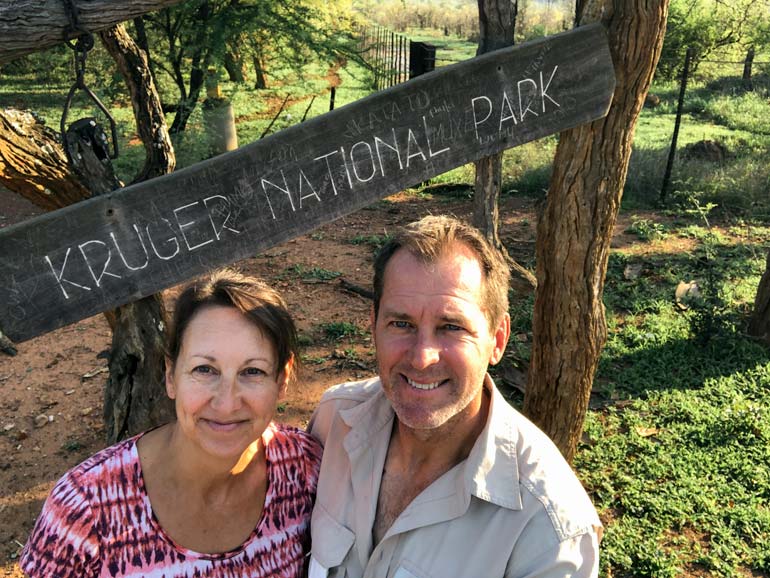
Kruger Self-Drive … AND THAT’S A WRAP
Are you planning a trip? Let us know if you have any questions, and we’ll try to help. In 2024, we are continuing our Africa Overlanding trip, including more of Southern Africa.
Follow us on Social Media here: Facebook and Instagram
You can check out our Etsy store here: Lifejourney4two Photography on Etsy.
If you have Pinterest you can pin and save it for later.
YOU MAY ALSO BE INTERESTED IN READING:
- Animal Encounters Around the World
- Birds in Kruger: Winged Wonders
- Driving in South Africa
- Three Fantastic Western Cape Mountain Passes
- Lesotho Road Trip
- Overlanding Botswana Tips and Tricks
Planning Your Travels?
These are the travel resources we recommend and use when planning our trips.
- 🚘 Car Hire: We use DiscoverCars.com
- Motorhome/Campervan Rental: We highly recommend the Motorhome Republic
- 🪪 Order your International Driver’s Licence online here
- 🛏 Book Accommodation: We use Booking.com to find accommodation that suits our budget
- 🐶 Pet Sitting/Pet Sitters: Check Out TrustedHousesitters here (Use our Discount code: LIFEJOURNEY25 for 25% off. )
- Activities and Experiences: Get Your Guide and Viator
- Travel Insurance: Safetywing or World Nomads
- 🥾 Travel Gear and Accessories: Check out our top picks here — Lifejourney4two page on Amazon
For a more thorough list, visit our Travel Resources page here.

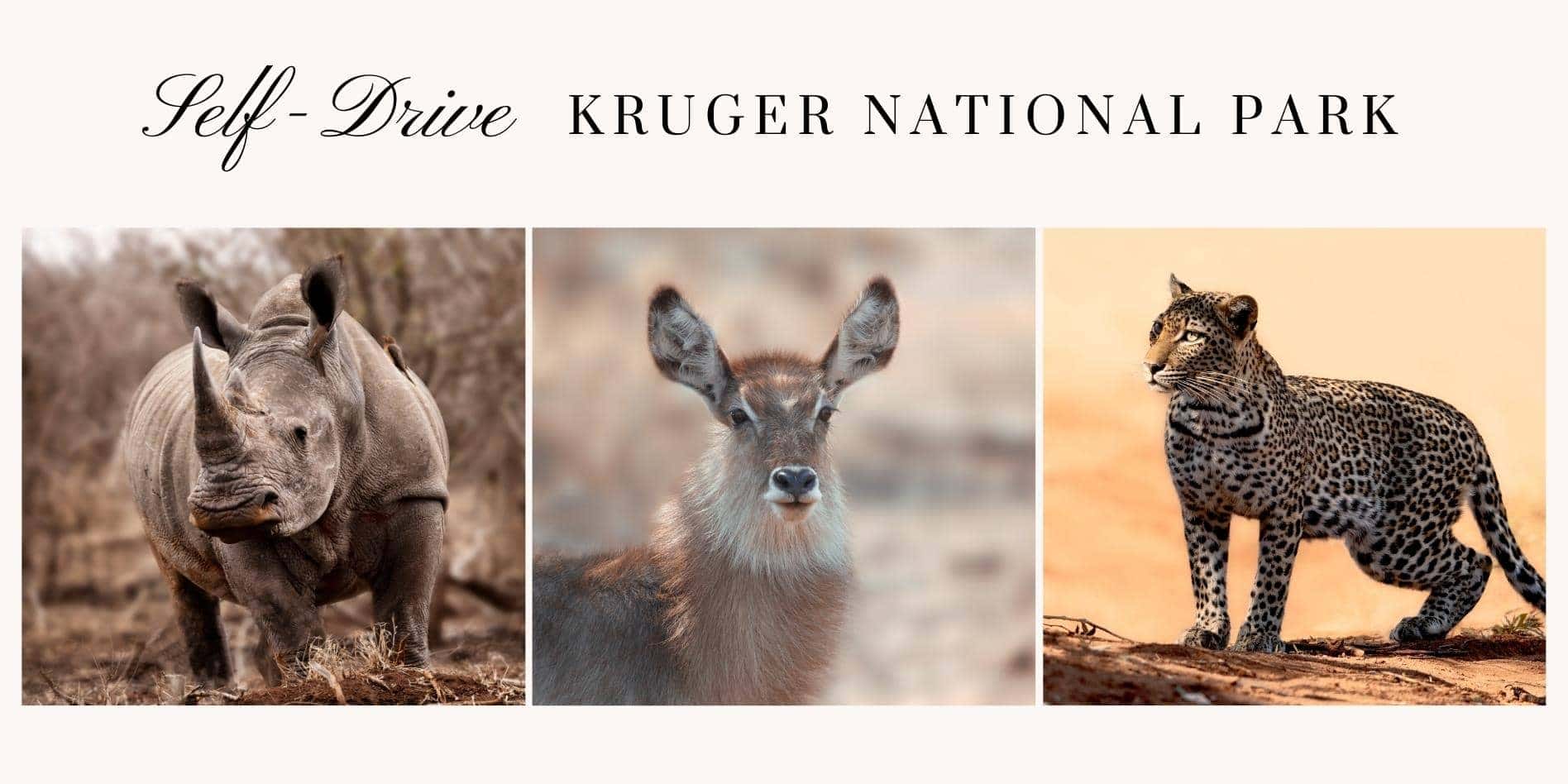

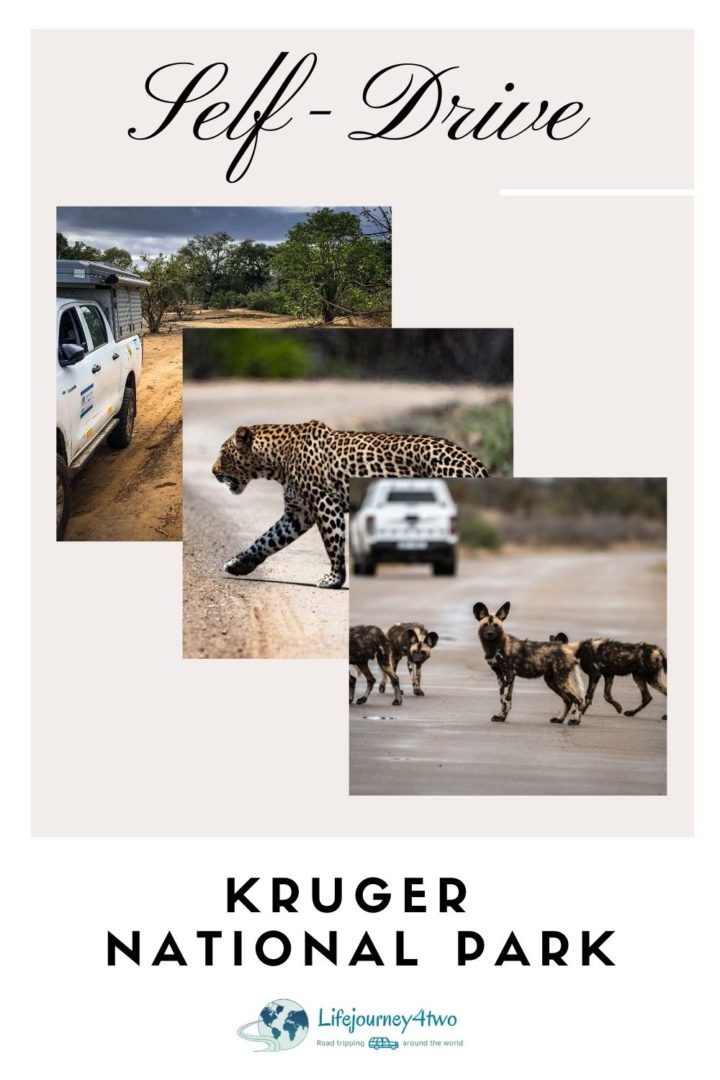
What a comprehensive and impressive guide, Shelley. All your advice sounds sound. When looking at your beautiful pictures it is hard to forget how long it must have taken to take some of them. Ellie & I have Kruger very high up on our list.
Thanks so much Stefan – Kruger is one of our absolute favourite places in the world … so far. And yes – it took a lot of patience to get some of the shots we did 🙂